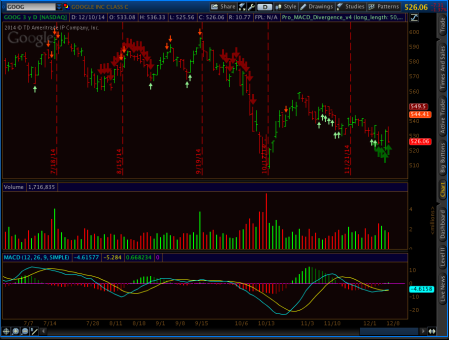Here’s a trade I entered in Apple about 2 weeks ago where I used the Swing VWAP and the RSI MultiDivergence indicators.
Back in January, the market had gone through a good decline. I was watching the RSI divergence on AAPL. Around that time, a big divergence showed up. This was about the largest in the last two years, and is circled on the chart below. Because of that context, I wanted to look for a long entry. After the swing low on January 3, AAPL kept above the Swing VWAP. It pulled back close to the Swing VWAP, and then on January 15 it had a bullish reversal candle (white arrow). That means the bears are losing, since it couldn’t penetrate the lower VWAP. I entered at the end of the day (yellow line) with a stop at the prior day’s low Swing VWAP (red line), and a target at $185 based on prior resistance.

So far, the trade is going according to plan. My stop is at $160 now, and I just have to manage when I take profits–at the predetermined target or in a discretionary manner. I’m really liking the Swing VWAP for how it tracks what side is winning and what side is losing. As a trader, your money comes from the losers. Markets move because they have to, and that happens because people are blown out of their incorrect positions.








A Look at a Few Charts Right Now
July 17, 2019Going into August is the time I have historically lost the most in my trades. I overtrade and try to push something through when the markets are in a choppy, listless environment. So one of my rules is that I don’t trade from the end of July through Labor Day.
That said, here’s a few daily charts I’ve been watching and what I think my indicators are telling me. I’m mainly looking at the ProSwingVWAP and the Multi-Divergence Indicator v2 on the RSI(20). Also plotted in a gray line is an indicator I’m working on called AdaptiveSuperSmoother. I prefer it over moving averages. More on that later. On to the charts:
$SPY (S&P 500 ETF)
The broad market. As far as divergence, there isn’t any. No hint of weakness on a longer timeframe. The lower Swing VWAP is far below, so no definitive trend change. Since the middle of June we’ve broken the upper Swing VWAP 6 times. Today’s weakness doesn’t look good for continuing that streak, however. This looks like a textbook chart for sideways chop. This tells me take August off.
$AAPL (Apple Computer, Inc)
I am always and everywhere a big Apple fan. Slightest of slight bearish divergence. Nothing compared to what we saw at the end of April. I’d ignore that here. The upper Swing VWAP points are barely grinding higher, so no real bullish drive. Not near the recent high in May. The lower Swing VWAP is well below the current price, so no likely trend reversal indicated yet. All signs point to blowing up your account overtrading it in August.
$ROKU (Roku Inc.)
Roku has been a monster all year. Into June, a large bearish divergence showed up as it pushed above $100. We got a 10% drop after that, and the divergence ended. In the first part of July there was an upper Swing VWAP breakout at about $95. I most recently went long there at $97. Pushed back up to new highs where we are now. The drop today seems like a rejection of that newest high. The lower Swing VWAP is down at $100. Below $100 I’d look for a trend change to bearish. It would take strength above $114 to look like a continued uptrend. Another sideways chart, though I see more of a downside risk here. I’m still long here but wouldn’t add at this time, and will watch $100 closely.
$TSLA (Tesla Motors, Inc.)
Tesla is interesting here. A bullish divergence back in early June signaled a potential trend change upward. Tesla demolished upper Swing VWAP’s from that point onward. The lower Swing VWAP from that big reversal has still not been tested. Strong uptrend. The latest weakness today after another upper break doesn’t inspire confidence, and we are far from the Adaptive Super Smoother “average” price. Kind of extended. It looks like Tesla’s bull trend is still intact, but this isn’t the time to get on board, especially with the broad market likely to languish for a while. The upside target would likely be about $290 resistance from the April highs, but I wouldn’t expect that to happen until the fall. With earnings coming up between now and then, it’s a wait-and-see chart here.
So it’s a whole lot of nothing out there. Sit on your hands or play with Bitcoin pinless hand grenades. Crypto is making biotech names seem like investment grade. With the yield curve inverting and possible recession looming, the end of the year should be interesting.
Tags:divergence, market_environment, swing_points, trend, vwap
Posted in Market Commentary, Thinkscript | Comments Off on A Look at a Few Charts Right Now